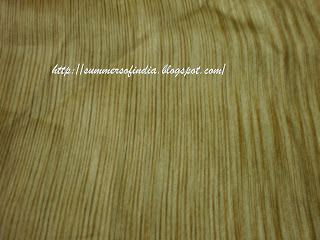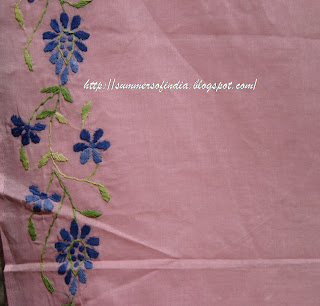India is a treasure house of various Arts and Crafts since ancient times. These have been handed down from generation to generation, each time not only preserving the past traditions, but also creating and adding new techniques or forms due to the influence of people, culture and arts from other countries who came to India from time to time as well as changing tastes according to the times. This has refined the art or craft forms in the process, such that today we have such exquisite and priceless creative techniques.
I myself am discovering so many different Arts N Crafts every time I visit a place or meet people from different regions. In this post I am going to share with you one of such traditional art form-“KALAMKARI. I did not know much about this art until my aunt married into one of the oldest and well known families from Machilipatnam. My uncle is connoisseur of arts and crafts and through him I learned more about this craft. Still my knowledge is very little.
Origin and History:
Kalamkari was originally known as VrathaPani. Vratha in Telugu means writing or drawing and Pani means hand-so it means hand drawn. Later on it became popular as Kalamkari. In Urdu, Qalam- Kalam means pen and Kaari is art or work. So Kalamkari means art drawn with pen.
In ancient India, the story tellers played a very important role in spreading the culture and keeping alive the Indian Epics of Ramayana and MahaBharatha. This was one of the forms of entertainment the people had in those days. The story tellers, consisting of singers, musicians and other artists like painters, roamed from village to village, reciting stories, from Ramayana, Mahabharatha, Puranas and other folklore legends. Later on, in order to attract the attention of audiences, the painters in the troop used to paint pictures on cloth, paper, leaves and other such media using naturally and locally available vegetable dyes. This was done on the spot most of the times. So basically picture of Gods, Goddesses and other Mythological, folklore characters, etc were painted.
More over banners and scrolls painted were also used for adorning temple walls or chariots (temple cars used for religious processions) during festivals and other religious functions. Kings, land lords and rich would get these paintings done and gift them to temples or for adorning the walls of their dwellings. In fact most of the Indian folk painting forms originated and survived because of this.
Kalamkari a very ancient form of painting might have been developed as such. Later on it enjoyed the patronage of Mughals and Golconda Rulers. The painted articles were good sources for earning income through trade and export.During 16th and 17th centuries, this art form was quite popular. Later on it declined but was said to be revived to some extent by the British. However the modern day Kalamkari owes its existence to Smt. Kamaladevi Chatopadhyaya, the first Chairperson of All India Handicrafts Board.
Styles And The Materials Used:
These are the distinct styles of Kalamkari:
- Srikalahasthi Style-Painted with hand with the help of a pen like instrument
- Machilipatnam Style-block printed
- Karrupur from Thanjavur in TamilNadu is done on hand woven gold brocade fabric
Cotton fabric was and still is being used for this purpose as it is most suitable and cheap. Silk fabrics were/are also used but are quite costly. In the present day scenario, other synthetic materials are also being used. Still cottons and silks are more suitable and look beautiful, being natural fibres.
In the material produced by Srikalahasthi artists, a pen made of bamboo or palm wood, sharpened at one end is used for drawing the motifs. In Machilipatnam, wooden blocks carved with the designs are used for printing. The outlines and main or important features are first printed using these blocks. Later on the finer details are filled in using the pen. This allows for mass production. However, the finer details are not much clear. So the products from Kalahasthi do stand out as unique and beautiful.
The colours used are natural dyes extracted from vegetables or plants-leaves, roots, flowers, minerals etc. Cow dung, milk and other natural products are also used in the process.
Artisans and Patronage:
The designs and motifs used in this art have been quite distinctly been influenced by the patronage of different rulers like any other art form. There may be many similarities between the styles but there are also some features unique to each style which sets them apart.
In Machilipatnam, weavers were involved in this art form. They were patronized by the Golconda Sultanate and the Mughals. This form consists of motifs, designs reflecting the influence of Persia. These designs are intricate and remind us of those on the walls or Tajmahal or other such Mugal constructions and Art.
In Kalahasthi, the Balojas, who were bangle makers, took up this art. They were patronized by the Hindu rulers. Hence they catered to the needs of the temples and other religious ceremonies. Their art was centered on the themes from Hindu Mythology and Epics. Gods and Goddesses, scenes from Ramamyanam, Mahabharatham, Bhagawatham, figures of deities, elephants, divine birds and animals etc were painted surrounded by intricate borders.
In Karrupur, Kalamkari was used to embellish the gold brocade edges woven fabrics. These were under the patronage of Raja Sarfoji and Shivaji. The Royal family members used to wear these fabrics as dhotis and saris.
Under the British Raj, the use of Kalamkari fabric was entirely different. They were used for furnishings-bed linen, curtains and also for making garments. So floral designs preferred by the English were brought into use. They even painted portraits of English men in Kalamkari. These fabrics also constituted one of the varieties of the Chintz which was much in vogue during that period.
It became almost extinct at one time. After India gained Independence, our Handicrafts Development Board took up the task of reviving this art. Today our crafts men have not only retained and revived the traditional motifs and designs but are also evolving new ones to cater to the needs of the modern age. Quite recently we have seen a surge of huge demand for this work being used as patches or appliquéd on saris, and other dress materials.
In every textile and craft exhibition you see there are some stalls selling Kalamkari products. Here you can see a wall hanging of Arjuna and Lord Krishna on their way to the famous Mahabharatha war and some patches of peacocks.
For those who want to know more..Here is the link:
I have been collecting quite a few pieces. So brace yourselves, I am going to post more on Kalamkari...Keep a watch on my blog friends....

EC.jpg)
EC.jpg)
EC.jpg)
EC.jpg)
EC.jpg)
EC.jpg)
EC.jpg)
EC.jpg)
EC.jpg)

EC.jpg)
EC.jpg)
EC.jpg)
EC.jpg)
EC.jpg)
EC.jpg)

EC.jpg)
EC.jpg)
EC.jpg)
EC.jpg)
EC.jpg)
EC.jpg)
EC.jpg)
EC.jpg)
EC.jpg)
EC.jpg)
EC.jpg)
EC.jpg)








EC.jpg)
EC.jpg)
EC.jpg)




